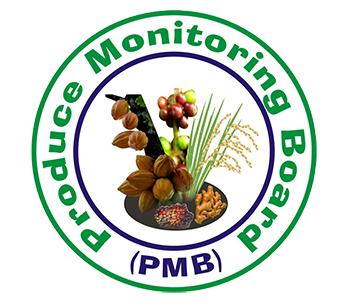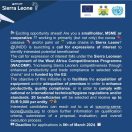Equipment
- Basket for individual picker
- Holding hooks for bringing branches into position for picking.
- Ladder
- Containers e.g. bags, jerry cans, etc. for transporting large quantities of berries from the orchards/farms to the processing area.
Depending on the region where coffee is being grown, the coffee beans can be harvested as little as once per year to as much as year round, depending on the variety and climate, when the plant flowers and fruits is dependent on the cycle of rainy seasons.
The coffee berries are ready 8 – 9 months after plant flowers. The desired berries is shiny, orange red or orange yellow in colour and firm to the touch.
The first harvest is 2 – 3 years after planting, with full production of 4.5 years. There are both mechanical and manual ways to harvest the berries.
In Sierra Leone, coffee is harvested in November/January by hand, only the ripe berries are chosen leaving the unripe fruit to be picked later. The berries are collected in containers such as baskets, bags, etc
SORTING OF BERRIES
If selective picking of cherries was done, that is, picking ripe cherries only and leaving the unriped ones, there would be no need for sorting. But stripping and mechanical harvesting were used, where ripe, unripe and matured beans are harvested. Then there would be need for sorting of beans.
The primary processing of coffee berries is in two methods. The dry and wet processing in which 90% of the coffee beans are dry processed.
Dry method
Two stages are involved
- Drying of the fruit (coffee berries).
- Removal of the dried coverings in a single manual operation (hulling)
In the dry processing berries are sun-dried and then hulled to free the seeds.
The remaining thin parchment over the bean is then removed by exporter with a mechanical operation that produces clean bean of varied sizes.
Wet method
This method is perceived new by many farmers and required stakeholders’ intervention for it adoption.
Coffee drying
Drying is practiced on cemented area or in best cases on mats exposed to the sun. Berries in the course of drying are protected from animals, small ruminants, of the poultry, the rain and the moisture of the night-humidity. Only few farmers use drying tables with mats, in some areas introduced by NGOs. Drying coffee, unlike cocoa, is not a major problem as harvest falls into the dry season. Thus 8 days for drying might be enough to reach the internationally required 10% of moisture content.
BAGGING
Good beans are put into jute bags and the use of Nylon bags should be discouraged as it lead to deterioration of produce.
A standardized bag of coffee for export weighs 62.1 kg (137 lb) gross wright (net beans wright 60.3, empty jut bag 1.2 kg).
Before inspection and grading is done, sorting is done first by removing defective beans such as black beans, abnormally, pale beans, badly broken beans (c ½ a bean) or beans damaged by insects.
Coffee which is thoroughly dry, clean and free from extraneous matter from all trace of mustiness and which contains not more than 30% by count of defective beans shall be fit for export.
GRADE A / FAQ
Coffee which is Robusta/Liberica type and which is free from any mixtures of other varieties of coffee and which contains not more than 10% by count of defective beans.
GRADE B
Coffee that has more than 15% defective beans, but less than 20% and does not have more than 2% black beans.
UNGRADED
All other coffee which does not qualify for grad A and B.
STEPS INVOLVED IN SAMPLING AND GRADING
- Random extraction of beans from bags.
- Spread on a table, mat, tarpaulin or other clean surface but not on the bare/naked floor.
- Thoroughly mix, seeing that no part of the bulk under examination appears to be of different variety, it is clean, dry and free from mustiness and extraneous matter.
- Extraneous and inferior part should be removed from bulk under examination and treated as a separate parcel from the remainder.
- Average representative sample indiscriminately from all parts of the parcel, which is a final sample of not less-than one (1) pound (0.45kg).
- If parcel exceeds 5 tons, it is sub-divided into parts of convenient size, not exceeding 5 tons each.
Examine each part as a separate parcel.
- From the final sample 500 beans shall be drawn indiscriminately for examination.
- A count made of the number of defective beans, determines the grade of the parcel of coffee.
STORAGE
The following criteria are considered favoured for the storage of coffee:
- Coffee shall be stored in premises constructed and operated with the objective of keeping the moisture contents of the beans sufficiently low, consistent with local conditions. Storage shall be on gratings or decking which allow at least 7cm of air space above the floor.
- It should be clean, properly ventilated and dry.
- It floors of concrete or wood and sound
- The interior walls thereof are washed annually with lime wash, methyl bromide or other approved disinfectant.
- It should not be within 20 feet (6.1m) of a cesspit or latrine.
- All reasonable precautions taken to protect produce from deterioration caused by excessive heat.
- Contamination with odours of flabours or dust from other commodities, both food stuffs and materials such as kerosene, cement or tar, is prevented.
- Height should be appropriate for the storage of good quality beans.
STACKING
Standardized bagged coffee shall be so stacked on raised wooden pallets and a space of about three (3) metres provided between stacks to allow easy movement of examiner(s) and other workers. Sixty (60) cm must be left between the bags and each wall for the building.
SEALING AND MARKING
After grading, each bag should be sealed with the individual examiner’s seal.
SHIPMENT
- Periodically during storage and immediately before shipment, the moisture content of each lot should be checked during recheck.
- (Check-Checking)
CONTAINER STUFFING
Stuffing requires the following materials:
- Cards for lining of container on both sides (walls)
- Dry bags/desiccant
- Container should be clean and dry.
TYPES OF CONTAINER
Twenty feet (20’) and forty feet (40’)
QUANTITY PER CONTAINER
- Twenty feet = 300 standardized bags
- Forty feet = 600 standardized bags
SEALING OF CONTAINER
For the purpose of quality assurance, the Quality Officer at the time of sealing the container shall take/keep record of the container Number and Seal Number. This should be done in the presence of the officer (Examiner/Inspector)



